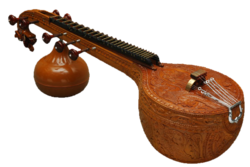Veena
The Veena (Sanskrit: वीणा, IAST: vīṇā), also spelled as Vina or Beena or Bina, is a multistringed chordophone of the Indian subcontinent. It is an ancient musical instrument that evolved into many variations, such as lutes, zithers and arched harps. The many regional designs have different names such as the Rudra veena, the Saraswati veena, the Mohan veena and others.
The North Indian design, that has been used in classical Hindustani music, is a stick zither. About 3.5 to 4 feet (1 to 1.2 meters) long to fit the measurements of the musician, it has a hollow body and two large resonating gourds under each end. It has four main strings which are melody type, and three auxiliary drone strings. To play, the musician plucks the melody strings downward with a plectrum worn on the first and second fingers, while the drone strings are strummed with the little finger of the playing hand. The musician stops the resonating strings, when so desired, with the fingers of the free hand. The Veena has been generally replaced with the Sitar in north Indian performances.
The South Indian Veena design, used in classical Carnatic music, is a lute. It is a long-necked, pear-shaped lute, but instead of the lower gourd of the north Indian design it has a pear shaped wooden piece. It too, however, has 24 frets, four melody strings, three drone strings, and played quite similar. It remains an important and popular string instrument in classical Carnatic music.
As a fretted, plucked lute, the Veena strings can produce pitches in full three octave range. The long hollow neck design of these Indian instruments allow portamento effects and legato ornaments found in Indian ragas. It has been a popular instrument in Indian classical music, and one revered in the Indian culture by its inclusion in the iconography of Saraswati, the Hindu goddess of arts and learning. These continue to be used, albeit with different designs, in Carnatic classical music and Hindustani classical music.
...
Wikipedia

